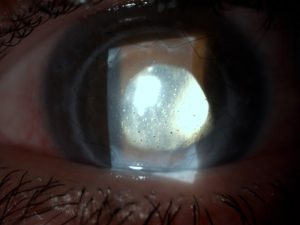Cornea transplantation is a medical procedure that can restore sight or significantly improve a person's visual quality. It is a fairly common surgical procedure that involves the complete or partial replacement of a damaged or diseased cornea with a healthy one from a donor. Knowing the stages of transplantation, the eligibility criteria and the post-operative expectations of this surgical procedure is crucial for patients who are offered this treatment option. In this article, we will explore what the surgery entails, its potential complications and the benefits it can offer.
Keratoplasty
The cornea transplant or keratoplasty is the surgical procedure whereby the cornea that has become opaque or deformed is replaced with a transparent corneal flap from a human donor.
The cornea is a convex transparent lens that covers the iris and pupil and is essential for focusing light on the retina.
In reality, a corneal transplant is not a true organ transplant, but rather a tissue 'graft', the purpose of which is to restore the quality of vision, compromised by the opacification or excessive curvature of the cornea to be replaced.
This intervention can only yield good results if there is no damage to the visual perception system, i.e. the retinal photoreceptors, or the nerve transmission pathways in the eye.
The transplantation surgical procedure is performed to improve vision and reduce the pain that can result from a damaged cornea. In cases of advanced disease, transplantation may be the only option to regain good visual quality.
It is important to emphasise that the success of the transplant depends on various factors, including the causes of the corneal damage and the general health of the patient. In many cases, surgery offers positive and lasting results.
When a Transplant is Needed
Corneal transplantation becomes necessary in various pathological conditions, such as in the case of progressive diseases such as keratoconusin which the cornea thins and deforms.
Also the corneal dystrophies eredo-familial can lead to the need for a transplant, as can bullous keratopathy or forms of keratitis that do not respond to other therapies. In fact, scarring caused by infections or eye injuries can make this intervention indispensable, as can happen in the case of Acanthamoeba keratitis.
Among the conditions that may require a corneal transplant, one must also add the aftermath of eye trauma and accidents at work or in the car, which can impair corneal transparency and/or curvature.
In order to determine suitability for transplantation, a thorough and comprehensive eye examination is essential to establish whether all the conditions are in place for a transplant to have a positive effect in terms of restoring sight.
Surgical techniques
Corneal replacement can be performed by means of two types of surgery:
1) lamellar keratoplasty: in this case, the cornea is only partially replaced. In superficial lamellar keratoplasty only the opacified portion of the corneal parenchyma is replaced, whereas in the deep lamellar keratoplasty the entire thickness of the parenchyma is replaced.
2) perforating keratoplastyin which case the entire cornea is replaced.
A number of corneal transplants, unfortunately, fail.
The main causes of failure are:
1) Post-operative infections.
2) Defects of the transplanted cornea: selection of donors and donated material is crucial as many corneas are not suitable for implantation.
3) Relapses of the original disease on the transplanted cornea
4) Immune reactions: these are the most frequent cause of transplant failure. They are more violent the earlier they occur. They generally lead to opacification of the transplanted corneal flap, but do not preclude the possibility of attempting a new graft later on.
Some serious eye diseases that are almost always bilateral (Stevens-Johnson syndrome, pemphigoid, severe burns, etc.) can damage the cornea so severely that a corneal transplant is very unlikely to be successful. In such cases, replacement of the altered corneal tissue with an artificial prosthesis made of transparent plastic material is used (keratoprosthesis).
Cornea donation for transplantation
First of all, it is good to know that Law No. 301 of 12 August 1993, which contains the 'Regulations on corneal removals and grafts', states that:
- Corneal removal requires theascertainment of death by instrumental means;
- the doctor who declares the death of the patient is obliged to give immediate communication to the nearest reference centre for corneal grafts;
- To donate you need the consentunless the person has expressly refused during his or her lifetime, the legally unseparated spouse, children of full age, and parents may consent to the donation request.
Pathological conditions precluding donation
Corneas from which corneas cannot be donated:
a) by persons suffering from transmissible infectious diseases (rabies, Creutzfield-Jacob disease, hepatitis B), active lue, septicaemia, AIDS and HIV, as well as neurological diseases such as Alzheimer's, senile dementia, schizophrenia, amyotrophic lateral sclerosis and numerous others.
b) from eyes affected by anterior segment inflammatory processes, corneal degenerative or dystrophic processes, anterior segment tumours or retinoblastoma.
The corneas of new-born or too small children are too thin and curved and can only be implanted in peers
Furthermore, to be suitable at transplantation, the cornea must present special conditions of viability of the corneal endothelium, which are usually verified at the Eye Bankswhich, in addition to this fundamental verification of tissue suitability, carry out a number of very important activities, ranging from obtaining consent for explantation from relatives (and related legal obligations), to harvesting, storing the explanted corneas and distributing them to the surgical facilities that require them.
History of corneal transplantation
Corneal transplantation has a long history dating back to the late 19th century. Initially, it was an experimental procedure, but over time it became an established practice due to technological advances.
In the early years, techniques were rudimentary and success was rare, but the results of keratoplasty operations have improved greatly since the introduction of important instrumental innovations, including the endothelial microscope and the corneal topograph.
In recent decades, transplantation techniques have seen further improvements with the introduction of laser surgery and lamellar transplantation techniques. These developments have increased the success rate and reduced recovery times, making the procedure more accessible and safer.
Symptoms and Diagnosis
Recognising the symptoms of a corneal problem is crucial for early diagnosis. Blurred vision, light sensitivity and eye pain are common symptoms.
An ophthalmologist uses various tests to diagnose problems with the cornea. Slit-lamp examination and corneal topography are standard procedures to assess the condition of the cornea.
An accurate diagnosis makes it possible to identify the severity of the problem and to plan the most appropriate treatment, which may or may not include a corneal transplant.
Cornea Transplantation Procedure
The corneal transplant procedure is a well-defined surgical procedure that requires careful and detailed preparation. In this section, we will explore the pre-operative steps and what happens during the procedure.
Pre-Operative Preparation
Preparation for a corneal transplant begins with a thorough evaluation by an ophthalmologist. The patient must undergo several examinations to ensure that he or she is a suitable candidate.
- Blood tests: To ensure that there are no active infections.
- Vision assessmentTo determine the severity of the visual problem.
- Medical consultation: To discuss medical history and current medication.
The patient receives specific instructions on what to do before surgery, such as avoiding certain medications and not eating or drinking in the hours beforehand.
Aspects of Surgery
During the procedure, the surgeon removes the damaged cornea and replaces it with a donor cornea. The procedure generally takes place under local anaesthesia, and the patient is awake but feels no pain.
- EngravingThe surgeon makes an incision in the damaged cornea.
- Corneal removalThe diseased cornea is gently removed.
- Insertion of the transplantThe new cornea is precisely positioned and sutured.
This generally takes a couple of hours and, once completed, the patient is monitored while awakening from anaesthesia.
Recovery and Post-Operative Care
Post-operative recovery varies from person to person. In the postoperative period it is common to experience blurred vision, sensitivity to light and mild discomfort.
Vision gradually improves over weeks or months. The patient must follow a strict regimen of eye drops to prevent infection and reduce inflammation.
Follow-up visits are essential to monitor healing. The ophthalmologist check for signs of rejection or other complications.
Risks and Potential Complications
Although corneal transplantation has a high success rate, but like any surgical procedure, corneal transplantation carries certain risks of  complications. The corneal rejection transplant is one of the most common and can occur when the patient's body recognises the new tissue as foreign.
complications. The corneal rejection transplant is one of the most common and can occur when the patient's body recognises the new tissue as foreign.
Infections, increased intraocular pressure and scar formation are other potential problems. It is important to recognise the symptoms early in order to deal with possible complications immediately.
How to Manage Risks
Managing the risks associated with a corneal transplant requires active collaboration between the patient and the doctor.
Some recommendations:
- Strictly follow the prescribed dosage regimen of eye drops.
- Undergo all scheduled check-ups.
- Report any changes in vision or unusual symptoms immediately.
- Avoid intense physical activity.
- Wear protective goggles to avoid eye trauma.
Following these recommendations reduces the risk of complications and promotes faster recovery.
